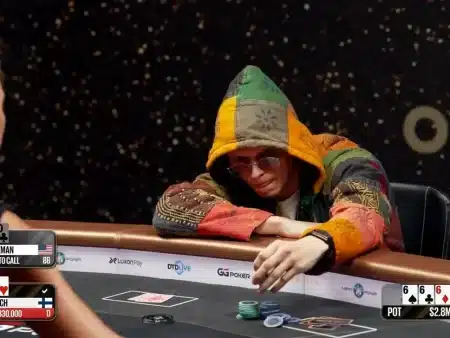Managing your poker bankroll is probably one of the most important things you can do if you want to stick around in this game for the long haul. Lots of folks have the skills but still blow up their stacks because they ignore basic bankroll management.
You’ll hear it all the time: don’t risk more than 5% of your total bankroll in a single game. That’s at least 20 buy-ins for whatever stakes you’re playing.

Pros know that keeping poker money separate from your personal finances is just smart business. This lets you make decisions based on logic and math, not whatever mood you’re in that day.
The 80/20 rule pops up a lot in poker, too—most of your profits will come from a handful of sessions.
Good bankroll management keeps you in the game when the cards turn cold. It’s that buffer that lets you play your best without sweating every pot.
If you follow these rules, you’re way more likely to avoid the classic boom-and-bust cycle that knocks out so many talented players.
What Is Poker Bankroll Management?

Bankroll management is basically the backbone of surviving in poker. It’s about handling your poker funds carefully so you don’t go broke when luck turns against you.
Defining Bankroll and Its Role
Your poker bankroll is just the cash you’ve set aside for poker—nothing else. It’s not your rent money or your grocery budget.
Think of it like your business capital. You need enough to survive the rough patches.
Even the best players hit losing streaks. That’s just how variance works.
The size of your bankroll decides what stakes you can actually play safely. Most pros keep at least 20-50 buy-ins for whatever level they’re at, but it depends on the game and how much risk you’re comfortable with.
Importance of Effective Bankroll Management
If you don’t manage your bankroll, you’re not going to last, no matter how good you are.
A proper bankroll gives you some peace of mind. You can focus on making the right plays instead of sweating every loss.
When you’re under-rolled, it’s easy to tilt and make rash decisions. Chasing losses or jumping up in stakes to get even almost never ends well.
Solid bankroll management also lets you move up in stakes when you’re ready, rather than taking wild shots just because you’re feeling lucky.
Key Principles for Sustainable Profit
Risk of Ruin: Pros keep their risk of busting out as close to zero as possible. That means never risking more than 5% of your roll in one go.
Game Selection: Pick games where you actually have an edge. Why battle sharks when you can find a softer table?
Stake Selection Guidelines:
- Cash games: 20-30 buy-ins
- Tournaments: 50-100 buy-ins (variance is brutal)
- Sit & Gos: 30-50 buy-ins
Moving up or down in stakes should be about your bankroll, not your ego. If you need to drop down, do it. It’s just part of the grind.
Setting Up Your Poker Bankroll
If you want to make it in poker, you need a real bankroll. It’s your safety net against the swings, and it lets you play your best game instead of worrying about every dollar.
Determining Appropriate Bankroll Size
How big should your bankroll be? Well, it depends on your skill and the games you play.
Most pros say you want at least 20-30 buy-ins for cash games and 50-100 for tournaments. So if you’re playing $1/$2 no-limit with a $200 buy-in, you’re looking at $4,000-$6,000.
If you’re just starting out, lean toward the higher end. The 80/20 rule applies here, too—most of your results come from a handful of sessions, so having a buffer is huge.
A few things affect your ideal bankroll size:
- The game you play (cash or tournament)
- Your edge over the field
- How swingy your game is
- How much risk you can handle
- If you have other income sources
Establishing Realistic Profit Goals
The best players set goals based on hourly rates or ROI, not just some random number. A solid win rate might be 2-5 big blinds per 100 hands in cash, or 20-30% ROI in tournaments.
Break your goals down:
- Daily: Try to focus on making good decisions, not just results
- Weekly: Track your hours and volume
- Monthly: Look at your win rate and adjust if needed
- Yearly: See how your bankroll has grown (or not)
Consistency is what really matters. Track your results and see if your goals line up with reality.
Segregating Poker Funds from Personal Finances
Keep your poker money away from your everyday expenses. Most pros have a dedicated account just for poker.
This keeps you from dipping into your rent money during a downswing. It also makes tracking your results and handling taxes a lot easier.
Some players set aside 3-6 months of living expenses as a backup fund. It’s not required, but it’s a nice cushion.
Regularly pulling out a percentage of your profits helps you stay disciplined. A lot of folks use something like the 50/30/20 rule: 50% back into the bankroll, 30% for expenses, 20% for taxes or savings.
Professional Bankroll Management Strategies
Pros don’t just wing it—they follow specific rules to protect their money and grow their roll over time. The details change depending on the game, your risk tolerance, and your personal goals.
Bankroll Management Approaches for Cash Games
Cash games are less volatile than tournaments, so you don’t need as big a bankroll. Most pros suggest 20-30 buy-ins for your usual stake.
For $1/$2 games with a $200 buy-in, that’s $4,000-$6,000. Online, you might want 30-40 buy-ins since the swings can be nastier.
If you hit a bad run, dropping down in stakes isn’t a failure—it’s just good sense.
Applying the Kelly Criterion and Other Tools
The Kelly Criterion is a fancy formula for figuring out how much to bet based on your edge. In poker, it means playing at stakes where your bankroll can handle the swings and still grow.
Most players don’t use the full Kelly amount—they go with half or even a quarter for safety.
Other tools worth checking out:
- Risk of Ruin calculators
- Bankroll-to-hourly-rate ratios
- Variance calculators
These help you make smarter decisions instead of just guessing.
Adjusting for Risk Tolerance
Everyone’s different when it comes to risk. Some like to play it safe with 40+ buy-ins, others are fine with 15-20.
If you’ve got a steady job outside poker, you can afford to be more aggressive. If poker’s your only income, it pays to be conservative.
Think about your responsibilities, how easy it is to reload, and how you handle downswings. A lot of pros get more cautious as their careers go on.
Utilizing Betting Tools and Trackers
Most serious players use software to track their bankroll and performance. Tools like PokerTracker and Holdem Manager show you your stats and variance.
There are also apps that track your bankroll and warn you if you’re getting close to danger territory. Some will even suggest what stakes you should be playing based on your current roll.
Variance calculators can show you how likely it is to lose a big chunk of your roll, even if you’re a winning player.
Session planning tools help you stick to stop-loss limits and avoid marathon sessions when you’re not playing your best.
Controlling Risk and Variance in Poker
If you want to survive in poker, you’ve got to manage risk and deal with the swings. The right strategies keep your bankroll intact and your head clear when things get rough.
Understanding Variance in Poker
Variance is just the natural ups and downs of poker. Even if you play perfectly, you’ll still have losing streaks because of the way the cards fall.
Sometimes you make the right move and still lose. That’s just poker.
Variance gets worse with:
- Big field tournaments
- Short stacks
- Aggressive play
- Higher stakes
To handle it, pros keep bigger bankrolls for swingy games. That way, a cold streak doesn’t knock them out.
Managing Downswings and Avoiding Chasing Losses
Downswings are part of the game. The trick is to recognize them for what they are—variance, not necessarily bad play.
When you’re running bad:
- Take a hard look at your game, but don’t assume it’s all your fault
- Stick to your usual strategy
- Drop down in stakes if you’re losing confidence
Don’t chase losses by moving up or playing wild. That’s a fast way to torch your bankroll.
Look at your results over big sample sizes—like 25,000 hands for cash or 500+ tournaments—so you can see your real win rate, not just a lucky (or unlucky) streak.
Implementing Stop-Loss Limits
Stop-loss limits are just pre-set points where you quit for the session to avoid digging yourself into a hole.
You might set a session stop-loss at 3 buy-ins, or a daily cap on losses. Weekly limits can help too.
Don’t let any single loss be more than 5-10% of your bankroll. If you hit your limit, walk away—no exceptions.
This keeps you from playing your worst game when you’re frustrated or tired.
Preventing Impulsive and Emotional Decisions
Emotions mess with your decision-making. You need strategies to keep your cool.
Try taking short breaks after a bad beat. Focus on making the best play, not the outcome.
Don’t get results-oriented—judge your hands by how you played them, not whether you won or lost. Breathing exercises can help if you feel tilt coming on.
A lot of pros have a pre-session routine—maybe reviewing notes or meditating—to get in the right mindset.
Keeping a poker journal to track your emotions can help spot patterns that lead to bad decisions. Over time, this self-awareness can give you an edge over players who can’t control themselves.
Optimizing Betting Practices and Patterns
Smart betting is how you stretch your bankroll and maximize profit. It’s about balancing risk and reward, and adjusting as the game changes.
Proper Bankroll Sizing Per Game
Pros have pretty clear guidelines for how much to bring to the table. For cash games, it’s usually 20-30 buy-ins for your regular stakes.
Tournaments are swingier, so you need more—usually 50-100 buy-ins for MTTs. If you’re playing $10 tournaments, that means a $500-$1,000 roll.
Games with softer fields might let you get by with less, but tougher games require a bigger cushion.
Cash Game Bankroll Guidelines:
- Low stakes: 20 buy-ins
- Mid stakes: 25 buy-ins
- High stakes: 30+ buy-ins
Evaluating Inplay Betting and Session Management
Good session management means knowing when to play and when to call it quits. Set time limits and stop-losses before you even start.
Stick to the 5% rule—don’t risk more than 5% of your bankroll in one session. Track not just your results, but also how you felt and played.
Table selection is still huge. Always look for games with a couple of weaker players. If the table gets tough, don’t be afraid to leave.
Some players use a “2-hour rule”—after two hours, check if you’re still playing well or if it’s time to take a break. Fatigue can wreck your edge before you know it.
Adapting to Changing Betting Patterns
The best players? They’re always tweaking their betting strategies as the game unfolds. You really have to notice when the table vibe shifts—sometimes it’s subtle, sometimes it’s like a slap in the face—and adjust how you play, right then and there.
It pays to keep an eye on how your opponents bet. Spotting those little habits they fall into? That’s gold. If the table suddenly gets more aggressive, maybe it’s time to tighten up your starting hands. On the flip side, when everyone’s just limping along, you might want to throw in more bluffs.
Messing with your bet sizes can do a lot to protect your bankroll. If you’re up against sharp players, keeping your bet sizes steady helps mask your hand strength. But if the table’s full of casual players, why not mix it up? Adjust your bets based on what you’ve got.
A lot of pros track how betting patterns change over time. Some use software, others just scribble notes, but the point is to spot trends—both in themselves and their opponents. This kind of data-driven thinking? It can really sharpen up your decisions.
Don’t forget about position. Seriously, it matters. You should be more aggressive in late position, where you get to see how everyone else acts first. That extra bit of info makes a difference.
Making Informed Decisions for Long-Term Success
Poker’s not just about knowing the rules or a handful of strategies. If you want to actually win in the long run, you’ve got to make decisions based on real data and solid advice. That’s what separates the grinders from the folks just hoping for a lucky streak.
Tracking Progress and Analyzing Results
If you’re not tracking your sessions, you’re basically flying blind. Keep notes on every session—buy-ins, cash-outs, which games you played. It sounds tedious, but it helps you figure out where you’re actually making money.
Some folks love spreadsheets, others go for fancy poker tracking software. Either way, you can crunch numbers like win rate, ROI, and variance. Glancing over this stuff now and then can reveal patterns you wouldn’t spot otherwise.
Ever heard of the 80/20 rule? In poker, it often means most of your profits are coming from a small chunk of your games. If you can find those sweet spots, you can focus your energy (and your bankroll) where it counts.
Learning from Valuable Insights and Expert Advice
Nobody gets good at poker in a vacuum. The best players are always soaking up knowledge—books, videos, forums, coaching, whatever works for them.
When you’re studying, try to zero in on stuff that actually matters for the games you play. No point grinding through advanced tournament theory if you only play cash at your local casino. It’s easy to get lost in the weeds.
Study groups can help, too. Find some folks around your skill level (or a bit better) and talk through hands together. It keeps you honest and you’ll probably pick up a few new angles.
One thing the experts always hammer on: table selection. Knowing when to walk away from a tough table can save you a lot of pain. Sometimes the smartest move is just finding a softer game.
Developing Discipline for Sustainable Profit
Discipline really is what sets successful poker players apart from your average gambler. It’s about resisting the urge to jump up in stakes just because you’ve hit a hot streak—easier said than done, right?
There’s this 50/100 rule that’s pretty popular: basically, you want 50 buy-ins for your current stakes before even thinking about moving up. If your bankroll dips below 30 or 40 buy-ins, it’s time to swallow your pride and move down.
That kind of structure helps you avoid going broke during those brutal downswings we all dread. It’s not glamorous, but it works.
But let’s be honest, emotional control is just as crucial. Focusing on the quality of your decisions instead of only looking at results can keep your head straight during losing streaks.
A lot of pros will tell you to step away after a big loss. Taking a breather can save you from going on tilt and making decisions you’ll regret later.
It also helps to set goals based on how well you’re playing, not just how much you’re winning or losing in the short run. Poker’s a long game, after all—those tiny edges add up, but only if you’re patient enough to let them.













